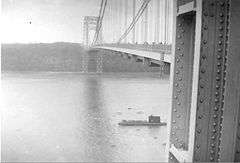George Washington Bridge
| George Washington Bridge | |
|---|---|
 | |
| Coordinates | 40°51′06″N 73°57′09″W / 40.851589°N 73.952483°W |
| Carries |
14 lanes (8 upper deck, 6 lower deck) of Upper deck sidewalk (south side): pedestrians and bicycles |
| Crosses | Hudson River |
| Locale | Connecting Fort Lee, New Jersey and Washington Heights, Manhattan in New York City, United States |
| Other name(s) | The GWB, The GW, The GW Bridge, & The George |
| Maintained by | Port Authority of New York and New Jersey |
| Characteristics | |
| Design | Double-decked suspension bridge |
| Material | Steel |
| Total length | 4,760 ft (1,450 m)[1] |
| Width | 119 ft (36 m)[1] |
| Height | 604 ft (184 m)[1] |
| Longest span | 3,500 ft (1,067 m)[2] |
| Clearance above | 14 ft (4.3 m) (upper level), 13.5 ft (4.1 m) (lower level) |
| Clearance below | 212 ft (65 m) at mid-span[1] |
| History | |
| Designer | Othmar Ammann, Cass Gilbert |
| Construction begin | October 1927 |
| Opened |
October 24, 1931 (upper level) August 29, 1962 (lower level) |
| Statistics | |
| Daily traffic | 312,377 (2014)[3] |
| Toll |
eastbound only: cars ($15.00 for cash, $12.50 peak with E-ZPass, $10.50 off-peak with E-ZPass; $6.50 when carpooling with 3 people or more with NY and NJ E-ZPass only) |
   | |
The George Washington Bridge – known informally as the GW Bridge,[4] the GWB,[5] the GW,[6] or the George[7] – is a double-decked suspension bridge spanning the Hudson River between the Washington Heights neighborhood of Manhattan in New York City and Fort Lee, New Jersey. As of 2015, it carried over 106 million vehicles per year, making it the world's busiest motor vehicle bridge.[8][9] It is owned by the Port Authority of New York and New Jersey, a bi-state government agency that operates several bridges, tunnels and airports, as well as marine seaports, and the PATH rapid transit system.
The bridge, an integral conduit within the New York metropolitan area, has an upper level that carries four lanes in each direction and a lower level with three lanes in each direction, for a total of 14 lanes of travel. The speed limit on the bridge is 45 mph (72 km/h), though congestion frequently slows traffic on both weekdays and weekends. The bridge's upper level also carries pedestrian and bicycle traffic. Interstate 95 (I-95) and U.S. Route 1/9 (US 1/9) cross the river via the bridge. US 46, which lies entirely within New Jersey, terminates halfway across the bridge at the state border with New York. At its eastern terminus in New York City, the bridge connects with the Trans-Manhattan Expressway (part of I-95, connecting to the Cross Bronx Expressway).
History
The bridge sits near the sites of Fort Washington (in New York) and Fort Lee (in New Jersey), which were fortified positions used by General George Washington and his American forces as they attempted to deter the occupation of New York City in 1776 during the American Revolutionary War. Unsuccessful, Washington evacuated Manhattan by crossing between the two forts.[note 1]
Construction on the bridge began in October 1927 as a project of the Port of New York Authority.[10] The bridge's chief engineer was Othmar Ammann, with Cass Gilbert as architect.[11] Geologists made 300-foot (91 m) test bores on the New Jersey side to determine if the geological strata would support the bridge.[12] When construction started, the estimated cost of the bridge was $75,000,000.[13] It was expected to carry 8 million vehicles and 1.5 million pedestrians in its first year of operation.[12]
Prior to and while under construction, the bridge was unofficially known as the "Hudson River Bridge". That name was the popular choice, chosen over a host of other proposed names as well as the Port Authority's preference for the name "George Washington Bridge", based on 1931 ballot voting submitted to the Port Authority by New York and New Jersey residents. However, the Port Authority named the bridge after George Washington that year.[14]
The bridge was dedicated on October 24, 1931, and opened to traffic the following day.[15][16] The George Washington Bridge, with a span of 4,760 feet (1,450 m) in total[1] – including a main span of 3,500 feet (1,100 m) – was the longest main bridge span in the world at the time, at nearly double the 1,850 feet (560 m) of the previous record holder, the Ambassador Bridge in Detroit. It held this title until the opening of the Golden Gate Bridge in 1937.[2]
In 1946, two more lanes were created on the current upper level, widening it from the original six lanes.[10] A second, lower deck, which had been anticipated in Ammann's original plans, was approved by Lt. Col. Joseph R. McCammon, U.S. Army Corps of Engineers and opened to the public on August 29, 1962.[17] The lower level, nicknamed "Martha" after George's wife Martha Washington,[18][19] increased the capacity of the bridge by 75 percent, and simultaneously made the George Washington Bridge the world's only 14-lane suspension bridge.[20][21]
The original design for the towers of the bridge called for them to be encased in concrete and granite. However, because of cost considerations during the Great Depression and favorable aesthetic critiques of the bare steel towers, this was never done.[11] The exposed steel towers, with their distinctive criss-crossed bracing, have become one of the bridge's most identifiable characteristics.[2] Le Corbusier (Charles-Edouard Jeanneret) said of the unadorned steel structure:
The George Washington Bridge over the Hudson is the most beautiful bridge in the world. Made of cables and steel beams, it gleams in the sky like a reversed arch. It is blessed. It is the only seat of grace in the disordered city. It is painted an aluminum color and, between water and sky, you see nothing but the bent cord supported by two steel towers. When your car moves up the ramp the two towers rise so high that it brings you happiness; their structure is so pure, so resolute, so regular that here, finally, steel architecture seems to laugh. The car reaches an unexpectedly wide apron; the second tower is very far away; innumerable vertical cables, gleaming against the sky, are suspended from the magisterial curve which swings down and then up. The rose-colored towers of New York appear, a vision whose harshness is mitigated by distance.— When the Cathedrals were White[22]
The George Washington Bridge was designated a National Historic Civil Engineering Landmark by the American Society of Civil Engineers on October 24, 1981, the 50th anniversary of the bridge's dedication ceremony.[2]
As the enclosed lower level is more vulnerable to hazardous material (HAZMAT) incidents than the upper level, most HAZMATs have long been prohibited there.[23] Following the September 11 attacks, the Port Authority also prohibited people from taking photographs on the premises of the bridge out of fear that terrorist groups might study photographs to plot an attack on the bridge, but the photography ban has since been lifted.
Since 2006, the bridge has flown the world's largest free-flying American flag, measuring at 90 feet (27 m) long, 60 feet (18 m) wide, and 450 pounds (200 kg). It is hoisted on special occasions when weather allows,[24][25] and appears on Martin Luther King, Jr. Day, Presidents Day, Memorial Day, Flag Day, Independence Day, Labor Day, Columbus Day, and Veterans Day, as well as on dates honoring those lost in the September 11 attacks.
In December 2011, the Port Authority announced plans to repair the bridge. For the first time, the vertical suspender cables would be replaced, at an expected cost of more than $1 billion paid for by toll revenue.[26] On August 5, 2013, repair crews began an $82-million effort to fix cracks in upper-deck structural steel caused by traffic, particularly heavy trucks. The plan called for replacing 632 road deck panels, which would add at least 20 years of service life to the roadway. The work proceeded at night, and was slated to be complete by year's end. But delays prevented completion and ultimately the work was halted for the winter.[27] It was restarted on June 16, 2014, and was expected to last another 12 weeks.[28]
From September 9 to 13, 2013, dedicated toll lanes for one of the local Fort Lee entrances to the bridge's upper level were reduced from three to one, the two given to highway traffic, without notification to local government officials and emergency responders on orders from aides and appointees of New Jersey Governor Chris Christie causing a political controversy called "Bridgegate".[29] The local toll lane reductions caused massive traffic congestion, with major delays for school transportation and police and emergency service responses within Fort Lee. The repercussions and controversy surrounding these actions have been investigated by the Port Authority, federal prosecutors, and a New Jersey legislature committee.
Connections and routes
Road access
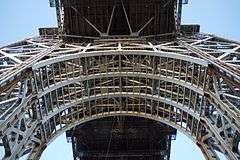
The George Washington Bridge carries I-95 and US 1/9 between New Jersey and New York. Coming from New Jersey, US 46 terminates at the state border in the middle of the bridge. Further west, I-80, US 9W, New Jersey Route 4, and the New Jersey Turnpike also feed into the bridge via either I-95, U.S. 1/9, or U.S. 46 but end before reaching it. The Palisades Interstate Parkway connects directly to the bridge's upper level, though not to the lower level (plans to give direct access to the lower level from the parkway have been postponed). The marginal roads and local streets above the highways are known as GWB Plaza.
On the New York side, the 12-lane Trans-Manhattan Expressway heads east across the narrow neck of upper Manhattan, from the bridge to the Harlem River, providing access from both decks to 178th Street, the Henry Hudson Parkway and Riverside Drive on the West Side of Manhattan, and to Amsterdam Avenue and the Harlem River Drive on the East Side. The Expressway connects directly with the Alexander Hamilton Bridge, which spans the Harlem River as part of the Cross-Bronx Expressway (I-95), providing access to the Major Deegan Expressway (I-87). Heading towards New Jersey, local access to the bridge is available from 179th Street. There are also ramps connecting the bridge to the George Washington Bridge Bus Terminal,[30] a commuter bus terminal with direct access to the New York City Subway at the 175th Street (A train) station on the IND Eighth Avenue Line.
Emergency services are provided by the Port Authority's Tunnel & Bridge Agents, who are stationed at the bridge 24/7 and maintain various apparatus such as fire trucks, rescue trucks, and wreckers specially designed for the GW Bridge for serious incidents, such as fires, vehicle extrications, Haz-Mat incidents, overturned vehicles, and many other emergencies. Emergency Medical Services are also provided by the Agents.
Tolls
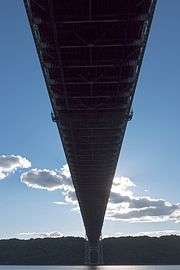
Eastbound vehicles must pay a toll to cross the bridge; as with all Hudson River crossings along the North River, westbound vehicles cross for free.[31] Tolls for the bridge cost $.50 one way in 1931, have been raised over the years, and increased to $15 cash for passenger vehicles on December 6, 2015.[32]
In 2006, bridge tolls totaled about $1 million per day; at the time, tolls for cars were $6 cash, $5 E-ZPass peak hours, and $4 E-ZPass off-peak hours.[33]
As of December 6, 2015, the cash tolls going from New Jersey to New York are $15 for both cars and motorcycles. E-ZPass users are charged $10.50 for cars and $9.50 for motorcycles during off-peak hours (outside of 6–10 a.m. and 4–8 p.m. on the weekdays; and outside of 11 a.m.–9 p.m. on the weekends) and $12.50 for cars and $11.50 for motorcycles during peak hours (6–10 a.m. and 4–8 p.m. on the weekdays; and 11 a.m.–9 p.m. on the weekends). Trucks are charged cash tolls of $20.00 per axle, with discounted peak, off-peak, and overnight (Sunday - Thursday 10 p.m.-6 a.m.) E-ZPass tolls. A discounted carpool toll ($6.50) is available at all times for cars with three or more passengers using NY or NJ E-ZPass, who proceed through a staffed toll lane (provided they have registered with the free "Carpool Plan"). There is an off-peak toll of $7.00 for qualified low-emission passenger vehicles, which have received a Green E-ZPass based on registering for the Port Authority Green Pass Discount Plan.[34]

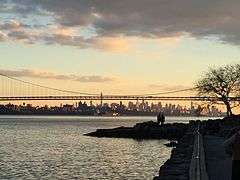

The bridge has 29 toll lanes: 12 in the main upper-level toll plaza, 10 in the lower-level toll plaza, and seven in the Palisades Interstate Parkway toll plaza leading to the upper level. The toll plazas on the lower level and Palisades Parkway are not staffed during the overnight hours and accept only E-ZPass transactions during this period.[1][35] Pedestrians and cyclists cross for free on the sidewalk. Though there are sidewalks on each side of the bridge, cyclists and pedestrians can use only the south side. The bridge offers spectacular views of the Hudson River, the Manhattan skyline, and the New Jersey Palisades. Pedestrians had to pay tolls of 10 cents shortly after the bridge opened, but non-motorized traffic is no longer tolled.[20]
In January 2007, the Port Authority of New York and New Jersey announced a two-year, $3.2-million deal with GEICO, the auto insurance giant, that would have posted a large billboard atop the toll plaza that said "GEICO Drive Safely," along with GEICO signs on the tollbooths and approach roads.[36] A week later, however, the Port Authority canceled the contract after critics said the signs would mar the landmarked bridge, that the Port Authority had failed to negotiate a good price for the deal, and that the signs might violate Fort Lee's regulations.[37]
Alternate routes
The George Washington Bridge is notorious for traffic jams during rush hour, as are the highways connected to it, including the Trans-Manhattan Expressway that turns into the Cross Bronx Expressway to the east, the Harlem River Drive that turns into the FDR Drive, the Henry Hudson Parkway that turns into West Side Highway to the south, and the Major Deegan Expressway (I-87) in the Bronx at the other side of the Harlem River at its interchange with I-95. The western approaches in New Jersey are also slow, specifically I-95, US 1-9, and 46 (merged before the bridge), Route 4, and the Palisades Parkway.
Within New York City, the Lincoln Tunnel (NJ 495) and Holland Tunnel (Interstate 78/NJ 139) also enter Manhattan, albeit further south. The Verrazano Bridge (I-278), which connects Staten Island with Brooklyn and also handles traffic from New Jersey, is an alternate route even further south. Within the New York metropolitan area, the Tappan Zee Bridge (Interstates 87/287 and New York State Thruway) is an alternate route further north that avoids the city proper.
For traffic from further away, such as traffic between New England (and points north/east) and Pennsylvania (and points south/west), Interstate 84, which crosses the Hudson on the Newburgh–Beacon Bridge, is often used as an alternative rather than either the GWB or the Tappan Zee Bridge, as it avoids the inner New York metropolitan area and is a less congested route.
Non-motorized access
The George Washington Bridge is popular among sightseers and commuters traveling by foot, bicycle, or roller skates. The South sidewalk (accessible by a long, steep ramp on the Manhattan side of the bridge) is shared by cyclists and pedestrians, with a level surface from end to end. The entrance in Manhattan is at 178th Street, just west of Cabrini Boulevard which also has access to the Hudson River Greenway north of the bridge. The sidewalk is accessible on the New Jersey side from Hudson Terrace, where a gate open in daytime and evening allows pedestrians and bikes to pass. Also on Hudson Terrace, less than one hundred yards north of the bike/ped entrance, walkers will find the start of the Long Path hiking trail, which leads after a short walk to some spectacular views of the bridge and continues north toward Albany. The George Washington Bridge carries New York State Bicycle Route 9, a bike route that runs from New York City north to Rouses Point.[38]
The Port Authority closed the north sidewalk at all times in 2008.[39] Though it offers direct access into Palisades Interstate Park, the north sidewalk requires stairway climbs and descents on both sides, which is impassable to people with physical disabilities and a risk in poor weather conditions.[40]
Transportation Alternatives, a New York City advocacy group, has proposed an enhanced River Road connector in Fort Lee, which would create safer pedestrian and bicycle access to the George Washington Bridge on the New Jersey side of the bridge.[41]
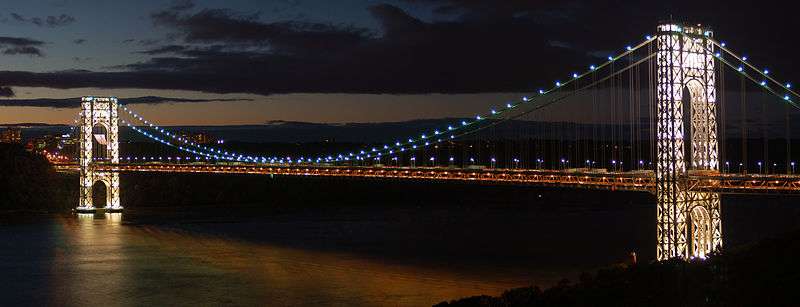
Suicides
The George Washington Bridge is among the most frequently chosen sites in the New York metropolitan area for committing suicide.[42]
In 1994, a caller into The Howard Stern Show was on the bridge threatening to commit suicide, but Howard Stern managed to talk him out of it.[43] The 2010 suicide of Tyler Clementi garnered national attention.
In 2012, a record 18 people threw themselves off the bridge to their deaths, with 43 suicide attempts overall.[44]
In popular culture
The landmark bridge is seen in many movies set in New York, mostly in establishing shots. The bridge is featured, along with the nearby Little Red Lighthouse, in Hildegarde Swift's 1942 children's book The Little Red Lighthouse and the Great Gray Bridge. The bridge is also featured in Francis Ford Coppola's The Godfather, Woody Allen's Broadway Danny Rose, Mike Newell's Donnie Brasco, and Abraham Polonsky's Force of Evil. On Sesame Street, Ernie often sang the words "George Washington Bridge" to the tune of Sobre las Olas ("The Loveliest Night of the Year").
In the 1976 film Network, the character Max Schumacher (William Holden) tells a funny story to his friend Howard Beale (Peter Finch), in which the young Schumacher, who overslept for a news shoot about the new lower deck at the bridge, gets into a cab wearing a raincoat over his pajamas and tells the cabbie to: "Take me to the middle of the George Washington Bridge." The cabbie, concerned that Schumacher intended to jump from the bridge, turns around and begs him: "Don't do it buddy! You're a young man! You got your whole life ahead of you!"[45]
See also
- List of fixed crossings of the Hudson River
- List of bridges documented by the Historic American Engineering Record in New Jersey
- List of bridges documented by the Historic American Engineering Record in New York
References
Explanatory notes
- ↑ In 1910, the Washington Chapter of the Daughters of the American Revolution erected a stone monument to the Battle of Fort Washington. The monument is about 100 yards (91 m) northeast of the Little Red Lighthouse, up the hill towards the eastern bridge anchorage. Renner, James (January 1998). "DAR Monument". Washington Heights & Inwood Online. Retrieved March 13, 2010.
Notes
- 1 2 3 4 5 6 "Facts & Info - George Washington Bridge". Port Authority of New York and New Jersey. Retrieved February 27, 2010.
- 1 2 3 4 "George Washington Bridge". ASCE Metropolitan Section. Retrieved November 12, 2016.
- ↑ Values per Port Authority of New York and New Jersey 2014
- ↑ Rose, Lacey (March 2, 2006). "Inside the Booth". Forbes. Retrieved January 15, 2008.
Like the PATH trains, which also connect New York to New Jersey, the G.W. Bridge is run by the Port Authority of New York and New Jersey, a public agency that employees 7,000 workers and has annual revenues of $2.9 billion.
- ↑ Toolen, Tom (September 27, 1995). "Bridges Keep Photographer in Suspense". The Record. Retrieved January 15, 2008.
Frieder calls the GWB 'the most beautiful suspension bridge in the world...'
- ↑ Jones, Charisse (October 20, 2006). "Upkeep Costs Rise as USA's Bridges Age". USA Today. Retrieved January 15, 2008.
The George Washington Bridge — locals call it 'the GW' — is one of a collection of dazzling spans that link New York's five boroughs or the city and New Jersey.
- ↑ Rockland, Michael Aaron (2008). The George Washington Bridge: Poetry in Steel. New Brunswick, NJ: Rutgers University Press. pp. 51, 56, 59. ISBN 978-0-8135-4375-8. Retrieved July 30, 2013.
- ↑ "Bridges & Tunnels". The Port Authority of New York and New Jersey. Retrieved February 16, 2015.
- ↑ Bod Woodruff; Lana Zak; Stephanie Wash (November 20, 2012). "GW Bridge Painters: Dangerous Job on Top of the World's Busiest Bridge". ABC News. Retrieved September 13, 2013.
- 1 2 "History - George Washington Bridge". Port Authority of New York and New Jersey. Retrieved March 6, 2010.
- 1 2 Richman, Steven M. The Bridges of New Jersey: Portraits of Garden State Crossings, p. 118. Rutgers University Press, 2005. ISBN 9780813535104. "The engineer, Othmar Ammann, and his architect, Cass Gilbert, had originally designed statuesque anchors, which were abandoned for cost reasons."
- 1 2 Staff (January 1930) "Giant of World's Bridges Rising in New York", Popular Mechanics p.464
- ↑ "Speeding the Hudson Bridge". Popular Science. November 1929. p. 49. Retrieved October 19, 2011.
- ↑ Maeder, Jay (February 17, 2011). "Name That Bridge, 1931 Edition". The New York Times. Retrieved March 18, 2011.
- ↑ "Two Governors Open Great Hudson Bridge As Throngs Look On". The New York Times. October 25, 1931. Retrieved March 6, 2010.
- ↑ "56,312 Cars Cross Bridge on First Day". The New York Times. October 26, 1931. Retrieved March 6, 2010.
- ↑ Ingraham, Joseph C. (August 30, 1962). "Lower Deck of George Washington Bridge Is Opened". The New York Times. Retrieved March 6, 2010.
- ↑ Rockland, Michael Aaron (2008). The George Washington Bridge: Poetry in Steel. New Brunswick, NJ: Rutgers University Press. pp. 81–82. ISBN 978-0-8135-4375-8. Retrieved July 30, 2013.
- ↑ Cameron, Jim (January 24, 2014) "A history of the George Washington Bridge" Greenwich Post. Accessed June 18, 2016. "The original designers had planned for the future, and in 1961 the lower level, six-lane 'Martha Washington' bridge opened to traffic, increasing total capacity by 75%."
- 1 2 "George Washington Bridge 80th Anniversary". Port Authority of New York and New Jersey. Retrieved October 30, 2013.
- ↑ Scott, Marvin. "Happy birthday George Washington Bridge! See rare 1981 interview with the man who crossed it ON HORSE on the first day", WPIX, October 25, 2013. Accessed June 18, 2016. "And with a total of 14 lanes, it’s the only one of its kind."
- ↑ Jeanneret-Gris, Charles-Édouard (1937). Quand les cathédrales étaient blanches [When the Cathedrals were White] (in French).
- ↑ "Transportation Regulations at Tunnel and Bridge Facilities" (PDF). Port Authority of New York and New Jersey. Retrieved February 27, 2010.
- ↑ "George Washington Bridge Interesting Facts" (PDF). Port Authority of New York and New Jersey. Archived from the original (PDF) on December 14, 2006. Retrieved May 28, 2007.
- ↑ "World's Largest Free-Flying American Flag to Fly at George Washington Bridge in Honor of 9/11 Victims" (Press release). Port Authority of New York and New Jersey. September 8, 2006. Retrieved February 27, 2010.
- ↑ Haughney, Christine (December 8, 2011). "Now 80, George Washington Bridge Will Undergo Repairs". The New York Times. Retrieved December 9, 2011.
- ↑ The Associated Press (August 2, 2013). "New York City's George Washington Bridge to undergo major construction project starting Monday". syracuse.com. Retrieved June 30, 2014.
- ↑ "Overnight repair work on GWB begins; 3 upper-level lanes close down". 7online.com. June 16, 2014. Retrieved July 7, 2014.
- ↑ Baxter, Christopher. "UPDATED: Timeline of Port Authority's George Washington Bridge controversy". The Star-Ledger. Retrieved March 31, 2014.
- ↑ Google (July 30, 2013). "GW Bridge ramps to GW Bridge Bus Terminal" (Map). Google Maps. Google. Retrieved July 30, 2013.
- ↑ "The Port Authority of NY & NJ - 2012 to 2015 Toll Rate Table (for Bridges & Tunnels)" (PDF). Port Authority of New York & New Jersey. Retrieved November 29, 2013.
- ↑ Strunsky, Steve. "How the George Washington Bridge toll has risen through the years", NJ Advance Media for NJ.com, December 5, 2014. Accessed June 19, 2016.
- ↑ "George Washington". New York Architecture. Retrieved October 10, 2013.
- ↑ "New Toll Fare Rates for the Bridges & Tunnels Effective December 6, 2015 at 3:00 AM". Port Authority of New York & New Jersey. Retrieved November 23, 2015.
- ↑ "Tolls - Bridges & Tunnels". Port Authority of New York and New Jersey. Retrieved February 27, 2010.
- ↑ Belson, Ken (January 4, 2007). "With Ad Deal, Insurer Wades Into Bridge Traffic". The New York Times. Retrieved February 27, 2010.
- ↑ Belson, Ken (January 9, 2007). "Agency Cancels Insurer's Ads for George Washington Bridge". The New York Times. Retrieved February 27, 2010.
- ↑ "State Bicycle Route 9 Maps - Southern Section". New York State Department of Transportation. Retrieved February 2, 2011.
- ↑ "Pedestrian & Bicycle Information - George Washington Bridge". Port Authority of New York and New Jersey. Retrieved February 27, 2010.
- ↑ Yellin, Deena. "A controversial planned GWB pedestrian lane attracts critics", The Record (Bergen County), October 12, 2014. Accessed June 19, 2016. " It includes replacing stairways on the bridge's north side with access ramps and removing a tight hairpin turn on the south side walkway to make it safer and accessible to wheelchairs."
- ↑ "Support Grows in NJ for GW Bridge to "River Road" Connector Path". Transportation Alternatives Magazine. Transportation Alternatives: 15. Summer 2003. Retrieved February 27, 2010.
- ↑ Zabriskie, Phil. "The Mysteries of the Suicide Tourist". New York Magazine. New York Media LLC. Retrieved April 13, 2012.
- ↑ Shock Jock Howard Stern Stops Caller's Suicide Leap : Media: Man phoned in threat from edge of bridge. Radio personality says he decided to 'keep this man laughing' until authorities could arrive. Los Angeles Times (December 8, 1994). Retrieved on July 23, 2013.
- ↑ Messing, Philip (January 14, 2013). "Sad GWB suicide record". New York Post. Retrieved January 14, 2013.
- ↑ "Network (1976) Quotes". Internet Movie Database. Retrieved June 25, 2014.
External links
| Wikimedia Commons has media related to George Washington Bridge. |
- George Washington Bridge Official Site Port Authority of New York and New Jersey
- NJ DOT map showing jurisdictions of highways leading to the bridge
- George Washington Bridge - Historic Overview NYCRoads.com
- George Washington Bridge Trivia
- Historic American Engineering Record (HAER) No. NY-129, "George Washington Bridge"
- George Washington Bridge at Structurae
- The George Washington Bridge in Heavy Smog, View Toward the New Jersey Side of the Hudson River from World Digital Library
- "George Washington Bridge: Spanning history" from BergenCounty.com

